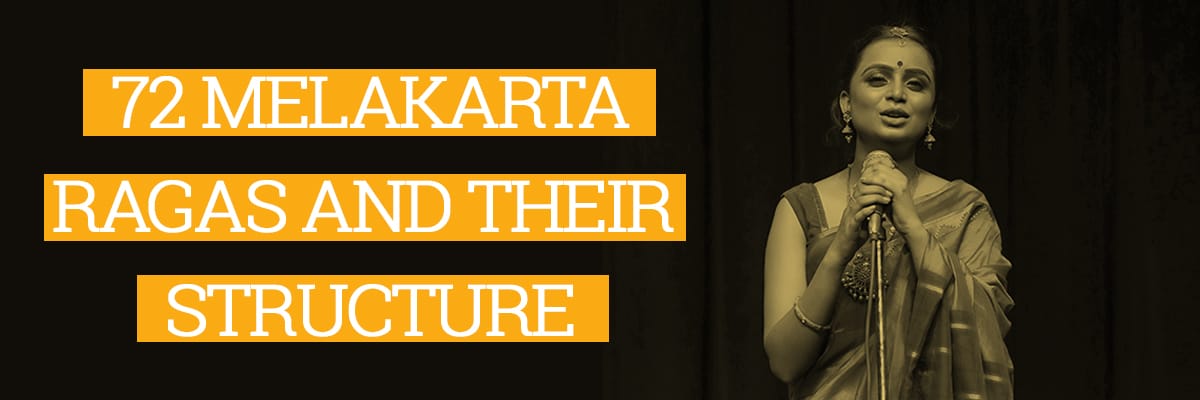
Introduction
A Raga in Carnatic music generally refers to the combination of appropriate swaras in the sequential order. Carnatic form of music has its significance and relevance globally that dates back to the early 14th century or even before! It is absolutely necessary to know about how a music system was organized and made it so authentic for us to explore till today. When we try to look into the system called the ‘Melakarta’ in Carnatic music we have the knowledge or the information that it consists of 72 ragas. But before 14th century these so called ‘Melakarta’ ragas were called as ‘Ragangaragas’ or were termed as ‘Raganga’ or ‘Bhashaga’ etc. We get the list of ‘Mela’ ragas in ‘Swami Vidyaranya’s’ Sangita Sara during the Vijayanagara Empire. After 14th century there was an evolution of the text. This ‘Melakarta’ scheme of having 72 ragas were conceptualized by a musicologist called Venkatamakhi during the 17th century.
What is a ‘Melakarta Raga’?
Mela in Sanskrit refers to a group and therefore, ‘Melakarta’ ragas are nothing but a representative of the swara sthanas of other ragas in Carnatic music. It was essential to classify the ragas into a group. The aim of classifying ragas were to bring the homogeneity in the variety of ragas that the ‘Mela’ accepts. These 72 ragas are called the ‘Janaka’ ragas which means ‘Parent’ ragas. Another concept is the ‘Janya’ raga which means the ragas ‘derived’ from a parent raga. Furthermore, these ‘Janya’ ragas are classified into various types based on their features. From the time of being just an abstraction, it came to a form wherein all the ragas were appropriate to be sung. Now, all the ragas have their unique forms to explore.
It is also interesting to know how these 72 Melakarta ragas in Carnatic music are divided and also an important concept as to how Carnatic music approach ragas in a systematic manner.
The structure of Melakarta ragas
They are divided into 2 halves (36+36). The first 36 ragas have ‘Shuddha Madhyama or Ma1’ and the second 36 ragas have ‘Prati Madhyama or Ma2’. These ragas have been further assigned in smaller segments called the chakras and within these 12 chakras we have 6 ragas each. In the first 36 ragas we have 6 chakras namely INDU, NETRA, AGNI, VEDA, BAANA, RUTHU. The next 6 chakras for the second 36 ragas are RUSHI, VASU, BRAHMA, DISI, RUDRA, ADITHYA.
Chakras and their assigned ragas
First 36 ragas that contain ‘Shuddha Madhyama or M1’:
- INDU - Kanakangi, Ratnangi, Ganamoorthy, Vanaspathi, Manavathi, Taanaroopi
- NETRA – Senavathi, Hanumathodi, Dhenuka, Natakapriya, Kokilapriya, Roopavathi
- AGNI – Gayakapriya, Vakulabharanam, Mayamalavagowla, Chakravakam, Suryakanthi, Hatakambari
- VEDA – Jhankaradwani, Natabhairavi, Keeravani, Kharaharapriya, Gowri manohari, Varuna priya
- BAANA – Mararanjani, Charukesi, Sarasangi, Harikambhoji, Dheera shankarabharana, Naganandini
- RUTHU – Yagapriya, Ragavardhini, Gangeyabhooshani, Vagadheeshwari, Soolini, Chalanata
Second 36 ragas that contain ‘Prati Madhyama or M2’:
- RUSHI – Salagamu, Jalarnavamu, Jhalavarali, Navaneetamu, Pavani, Raghupriya
- VASU – Gavambhodi, Bhavapriya, Shubhapantuvarali, Shadvidamargini, Suvarnangi, Divyamani
- BRAHMA – Dhavalambari, Namanarayani, Kamavardhini, Ramapriya, Gamanashrama, Vishwambhari
- DISI – Shyamalangi, Shanmukhapriya, Simhendramadhyama, Hemavathi, Dharmavathi, Neetimathi
- RUDRA – Kantamani, Rushabhapriya, Latangi, Vachaaspathi, Mechakalyani, Chitrambari
- ADITHYA – Sucharitra, Jyothiswaroopini, Dhatuvardhini, Nasikabhooshani, Kosalamu, Rasikapriya
Prerequisites for Melakarta ragas in the scheme:
- A ‘Melakarta raga’ must have Shadja (S) and Panchama (P), either one of the ‘Madhyama’ variants, either one of the variants of ‘Rishabha’ and ‘Gandhara’, either one of the variants of ‘Daivatha’ and ‘Nishadha’.
- A raga should have all the 7 swaras in the ‘Arohana’ and ‘Avarohana’ that is in the ascending and descending scale.
- The swaras must appear in a linear fashion to fulfill the requirement or eligible to be part of the system.